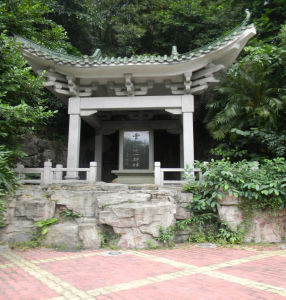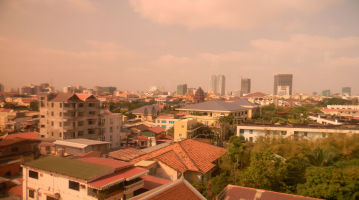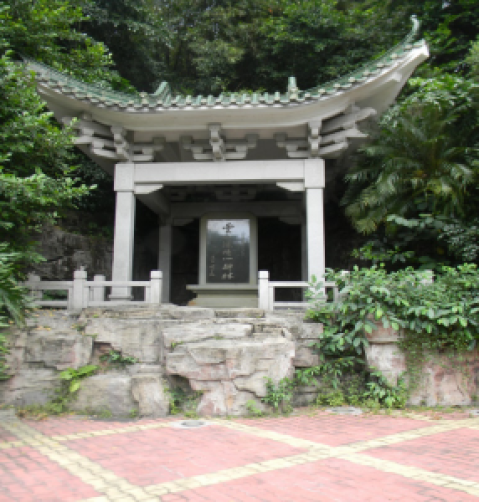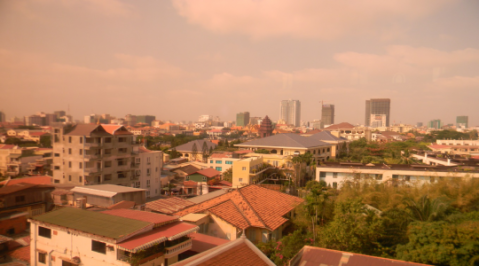Widgetized Section
Go to Admin » Appearance » Widgets » and move Gabfire Widget: Social into that MastheadOverlay zone
Public Service In A Place of Meaning: What We Can Learn From 13 Truckers
The views expressed are those of the author and do not necessarily reflect the views of ASPA as an organization.
By Lisa Saye
May 11, 2018

Memorial Park, Guangzhou, China, Photo by Lisa Saye
Random Choices
During the pre-dawn hours on the morning of April 24, Michigan State Police waved through 13 semi-trucks on I-696 to form a parallel barrier under an overpass to prevent a man from jumping off a bridge. The man didn’t jump. He lived. If you were to ask him what his lucky number is, what do you think he would say?
There has been quite a bit of talk, lately, about choice. But, what is choice, really? Can it simply be described as a selection among a group or set of options or is it more? Is choice a notion that we allow ourselves to believe we possess or has the choice been made for us and we are simply choosing what’s left. A choice should be more than left or right or up or down. A choice should inhabit a place of meaning.
Each day we are presented with a numbing vision of good and bad. Internet forums are inundated with posts and links that argue good is gone and bad is here to stay. This is the environment public administration operates within and the place where life-changing decisions are made. If we listen to the noise from the actual, virtual and digital streets, we then choose to ignore the cries of our citizens and chaos continues to grow.
We are social-problem practitioners who work in an industry that never closes. The Michigan State Police understood that and they used the most basic resource they had available to them when trying to save the life of a citizen. They asked for help. They asked random semi-truck drivers to stop what they were doing, stop where they were going and help. When we speak about diversity in public service, the example of the help this man received is as loud as it is clear. I think we oversimply what is meant by culture. Perhaps, I’m even ignoring the usual description just to fit the context of this column. In this case, I think I’m allowed a re-interpretation of culture and believe it to be directly connected to the concept of humanity.
When humanity strives to occupy a place of meaning, incidents of heroism become regular occurrences. Public administration has a place of meaning. Around the world, its legislation, its buildings, its people and its vast resources place meaning on its intentions to serve the public. As such, public administration has its own theatre, its own set of actors, directors and equipment that is poised to deliver a show of public service that will leave citizens wanting more.

Phnom Penh, Cambodia near Evening Twilight, Photo by Lisa Saye
Our Bluest Moments
Much of life happens during what is known as the blue hour or morning twilight and evening twilight. It is during this hour that the sun is low and the horizon appears to be blue. Blue is often the notion we apply to our sorrows and our low points in life. But, did you know that it is during the blue hour that flowers give off their strongest fragrance? Blue is a state of mind and for the public servant it is the time when we should choose to change the climate, the conversation or the lives of those who are too blue to do so for themselves. The citizens who come to us for help and assistance are not needy as they are — they are needy as we see them to be. I admire the public servant who knows the difference.
On April 24, I attended the United Nations Peace-Building and Sustaining Peace High-Level meeting in New York City. I was prepared to write about the worthwhile initiatives that the U.N. and its civil society organizations are planning to collaborate and implement for peace’s sake around the world. That is until I heard and read the story of what those 13 truckers did. I think I would be forgiven by all who attended the meeting, made speeches and participated in the dialogues if I chose instead to speak about the heroics of unnamed drivers on a stretch of highway near Detroit. I think that, like me, the attendees would point out and recognize the extraordinary service-in-action and would themselves tell the story again and again.
The United Nations headquarters in New York is one of those places of meaning spoken about earlier. So is that bridge in Michigan. When we assess what each place offers citizens at their bluest moments in life, we find that both are equal in significance and both are places where lives are changed through dialogue, collaboration and love.
I always tell my students meanings are operational, measurable results of something — an act, a rationale or a choice. Choose a legacy that insists on enhancing the lives of others and you will never be forgotten.
Join me in saluting the 13 who chose to sit, shoulder to shoulder, during one of our bluest moments.
Images: All images were taken by Lisa Saye in Guangzhou, China and Phnom Penh, Cambodia.
Author: Lisa Saye is Executive Director of The Policy Analysis Institute. She served as Fulbright Specialist in Phnom Penh, Cambodia and as International Consultant for the United Nations Development Program in The Maldives. Saye earned her Master’s in Human Resource Management from Troy University and her Doctorate in Public Administration from The University of Alabama. She can be reached at [email protected].






Paul Mohr
May 23, 2018 at 12:43 pm
I concur with your statement: “If we listen to the noise from the actual, virtual and digital streets, we then choose to ignore the cries of our citizens and chaos continues to grow”. Hopefully, the cries can be realized by the prevalence of more cogent leaders.
Dr. Lisa Saye
May 20, 2018 at 1:21 pm
Thanks so much for your kind words, Mike. I think the spirit of service to one’s neighbor is not only American, it is worldwide. Not a day goes by that one cannot read of instances around the globe of selfless individuals coming to the aid of their neighbors and strangers.
Mike Nwosu
May 18, 2018 at 8:06 am
My Prof,
Beautiful piece from a beautiful soul. We celebrate the 13 truckers. We celebrate the American society for being their brothers keeper. The American Spirit is what keeps them going when others give up.
Mike Nwosu
Dr. Lisa Saye
May 17, 2018 at 9:54 pm
Dyanne, thanks for reminding us of other examples of selflessness.
Dr. Lisa Saye
May 17, 2018 at 9:52 pm
Dr. Robinson, thanks again for your kind words and unending support.
Dr. Lisa Saye
May 17, 2018 at 9:52 pm
Thanks again, Hassan. I can always count on your candor and inspirational words.
Hassan Elkatawneh
May 16, 2018 at 10:05 am
An interesting article, I would like to join your voice in greeting the 13 who chose to sit shoulder to shoulder, to show the meaning of cooperation, may god bless you and bless them.
Marquice Robinson
May 14, 2018 at 4:42 pm
Dr. Saye great job with the article. You are a jack of all trades. You can pass for a photographer also, the photos are amazing. Well done!
Dyanne Mitchell-Williams
May 14, 2018 at 4:01 pm
Dr. Saye,
Thank you for always aspiring students of public service, and providing an avenue for us to stay on course. I am always amazed at the serviceable behavior of others, but it excites me to learn about the 13 truckers, I salute them also with our Tennessee hero who saved lives at a waffle house in the blue hours. Another excellent article for direction in government service.